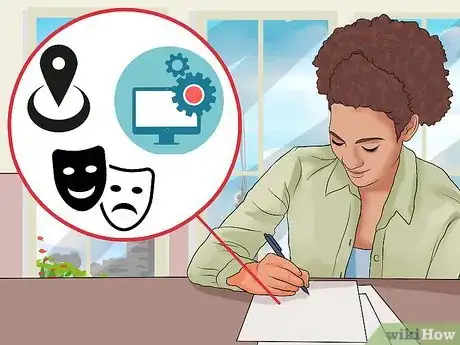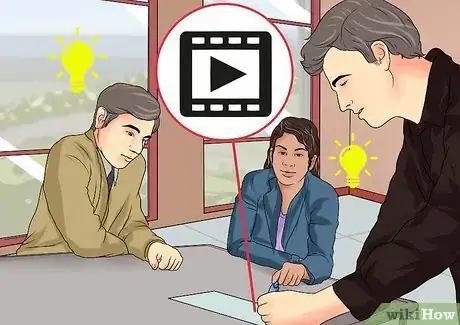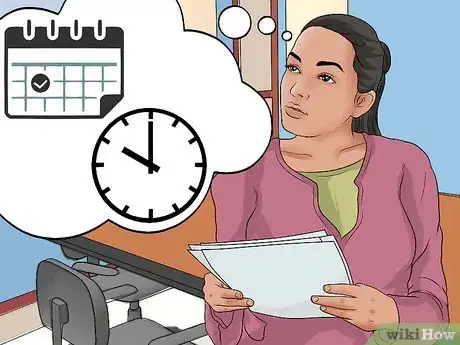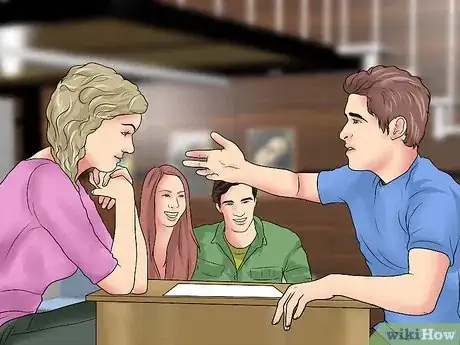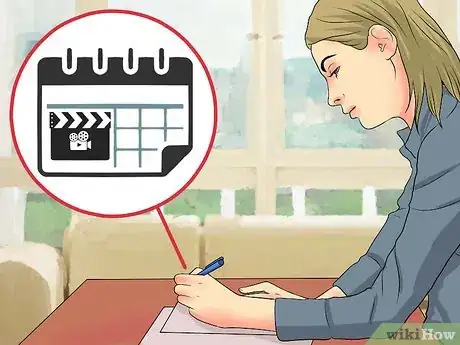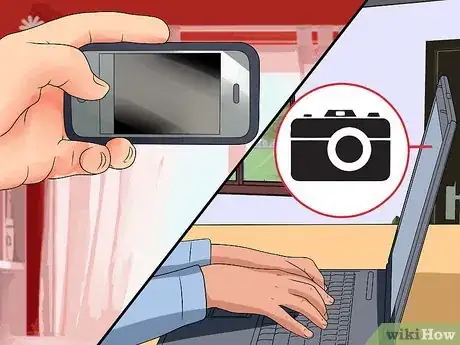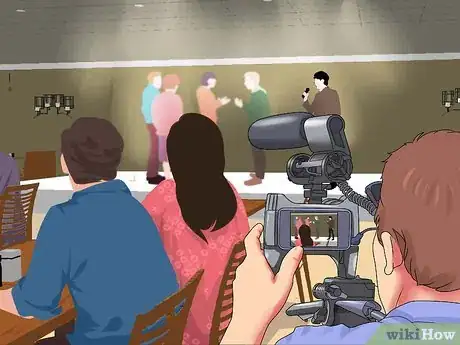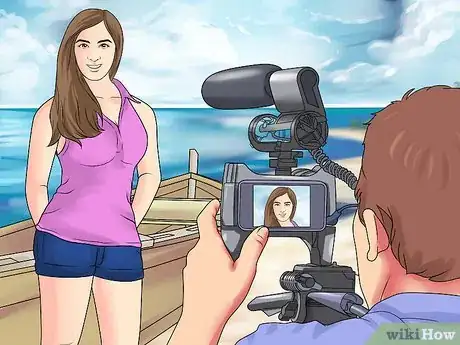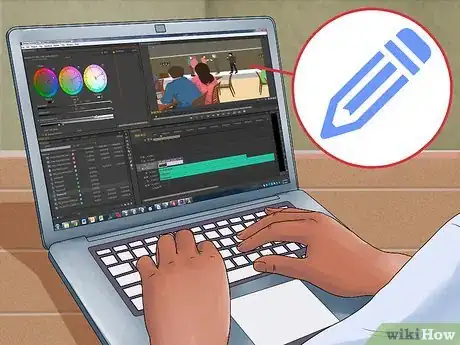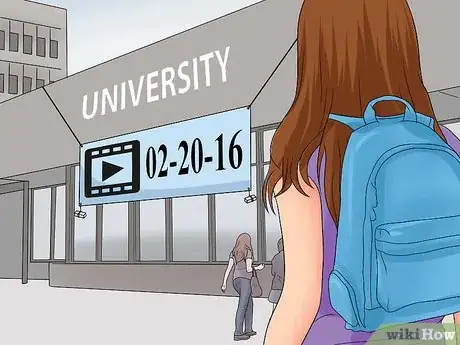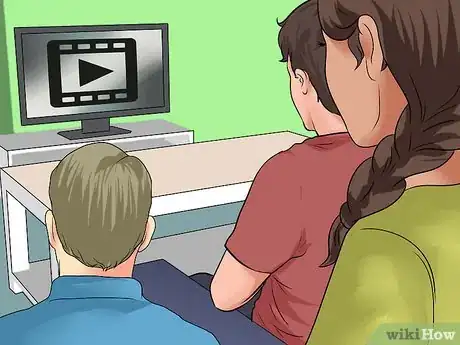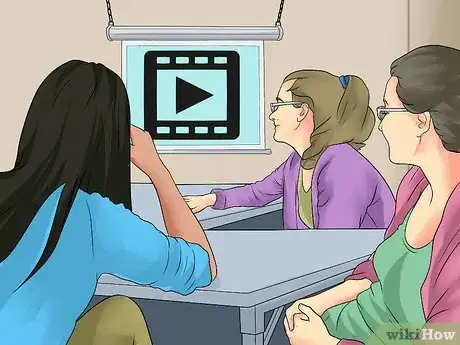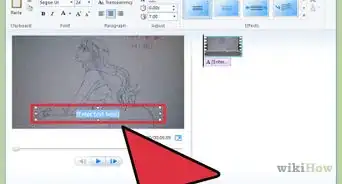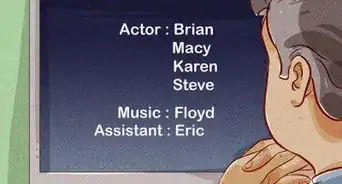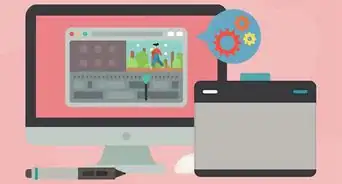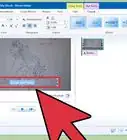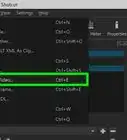This article was co-authored by Stephen Cardone. Stephen Cardone is the COO of NY Headshots, a New York City-based studio that specializes in shooting and producing headshots for individuals and businesses. Stephen has over four years of professional photography experience and over six years of documentary filmmaking experience. Stephen also works extensively as a photographer at NY Headshots. His work includes events, environmental photography, as well as headshots for actors, models, and corporate. He holds a BA in Non-fiction Writing from The New School.
This article has been viewed 22,426 times.
If you want to make a short movie you can do so using what you already have at your disposal. While using more advanced equipment is valuable, all you really need is a camera, your friends, and any other resources you currently have. A short movie should be quick and fun and with a little planning, you'll have produced one in no time. Come up with an idea. Write a script. Make a schedule. And then shoot and edit your own short movie.
Steps
Starting Pre-Production
-
1Make a list of your available resources. Before you do anything with your amazing movie idea, you need to figure out what resources you have available.
- Your resources include everything from a location to script writing software to actors. Embrace your limitations. Use what you have to help you come up with an idea for a movie you could make using what’s at your disposal.
- Compile a list of everything that you have available to you. Think outside the box. If you are at a film school, you’ll most likely have access to high-quality cameras, lighting and sound equipment. If you’re not, you may have to borrow stuff or use what you have. [1]
- When making a short movie, it’s ok to use the camera on your phone, as long as it’s a decent camera. Don’t worry so much about lighting and sound right now. While these elements are important, if you don’t have access to such equipment, write a script that won’t have you needing it.
- Think about your own wardrobe and your friends’. You probably won’t need to get costumes. You can wear your own clothes.
-
2Brainstorm ideas for your movie. With a list of all the resources you have to use, come up with a great movie idea.
- You can brainstorm alone or with a group of your friends. If you’re making this movie together, you should include everyone.
- Write your ideas down on paper or on a whiteboard. Discuss and collaborate with your friends on the ideas you come up with.
- At this stage of brainstorming, no idea is bad or stupid. Once you have plenty of ideas, then you can start narrowing down. Try combining multiple ideas.
- When coming up with an idea for your movie, be realistic about what you can do with what you have. And with short movies by ammeter filmmakers, making a comedy will be easier.
- If you want to make a movie about being in space, but don’t have a green screen and a budget for visual effects you may have to rethink your idea. Maybe you can be in space but decide that the movie will be shot entirely in one room you make to look like the inside of a spaceship.
Advertisement -
3Write a script.[2] Once you have your brilliant idea in place, it’s time to write your script.
- There are some things to note about writing a script for a movie. Roughly one page of your script equals one minute of film in your movie. For your short movie, you should not try to film something longer than ten minutes. Three to five minutes is best. [3]
- To write your script, you can use a script editing software like Highland, or Final Draft. However, these programs cost money and can be expensive. You can also write a script in a simple word processor like Google Docs. There are even some script writing extensions you can use to format it correctly. [4]
-
4Plan how to produce your movie. With your script in hand now it’s time to create a detailed plan of how you will shoot and produce your film.
- Create a schedule that you can follow. It should include dates and times for gathering all your equipment. Times for auditioning and casting your actors. And times for filming, and editing.
- You should talk to everyone who is helping you make this movie. Together find dates and times when you can film and plan for everything you need to do before you film. If you are renting or borrowing any equipment, know when you can get it and when you have to return it.
- Plan a day to find the locations of your film before you start shooting. If you are planning to shoot somewhere public you may have to get permission first. Plan when you’ll have the costumes and set ready. You should dedicate days to these types of tasks so that when it’s time to film, you don’t have to worry about missing anything.
-
5Cast your actors. If you are making this short movie with a group of friends, you may not need to audition any actors. You can just use yourselves.
- Regardless of how you get your actors you need to assign everyone a role. And make sure that the actors are available on the days you plan to shoot.
- Give your actors the script with enough time for the actors to memorize lines.
-
6Create a breakdown for every scene. Depending on how much equipment you have and how involved your scenes are, a breakdown can be very helpful. A breakdown is an itemized list of all the equipment, props, costumes, etc.
- There are several types of breakdowns when it comes to making a movie. But for a short movie, a producer’s breakdown is best.
- The producer’s breakdown covers five main areas: Where is the location you are shooting? Does the scene take place during the day or at night? Which characters are in the scene? What props are needed? How many pages is this scene? [5]
- For your short movie, you may not need the last part of the breakdown. But if you are filming multiple scenes it may be useful.
- You may want to storyboard. A storyboard is like a comic book drawing of each and every shot. It details how the camera will move, when the cut will happen, and includes details on the scene. It’s your preference if you think this will help. You may prefer just having an idea in your head.
-
7Create a final shooting schedule. Once you have everyone on board, have made your breakdown, and have planned your days it’s time to finalize a shooting schedule.
- Your breakdown will help you plan when the actors need to be where and when you can film what. Since you’re making a short movie, you may plan to shoot everything in one or two days.
- Coming up with a finalized schedule using all the information you have will allow you to decide what you can get done when. Something to note, filming almost always takes longer than you plan. Give yourself a buffer zone.
Shooting and Producing Your Movie
-
1Get familiar with your equipment. Before you shoot your actual movie, you’ll want to do some equipment testing so you don’t have any hiccups on the day.
- Even if you’re using your phone’s camera, make sure you’re familiar with all the options you have. Do some research on whichever camera or camera app you are using and learn how to adjust the lighting, the zoom, etc.
- If you are using light or sound equipment, test it out and do some test shots. Make sure that you know how to use the mics and how to position the lights for your desired results.
- Make sure that everything is charged and you have backup batteries ready for any equipment on the days you shoot.
-
2Rehearse the scene before shooting. Before you actually shoot your scene, have your actors rehearse it a couple of times.
- You can choose to film some of the rehearsal if you want, but the goal is to make sure your actors know the lines.
- This rehearsal time is also a good opportunity for you to make sure your shots are set up correctly. As well as make sure your actors are portraying the characters the way you envisioned.
- If you need to talk with the actors about a line or the way a character is being portrayed, be respectful. Don’t tell actors how to do something or how to deliver a line. Express what your vision is and discuss what you want.
-
3Begin recording principal photography. With your equipment all set up and the actors ready, it’s time to hit record and shoot your movie. Aim to short the bigger and more important stuff first.
- While filming you may come up with a new idea or see that something isn’t working and want to change it. That’s ok. But try to follow any storyboard you may have or plan you’ve discussed as best as you can.
- If something needs to be changed, for example, if you can’t fit everyone in the frame the way you wanted, you can make adjustments. But try not to completely change your plan at the last minute. Doing so could put you behind schedule and not everyone may agree with you.
- Once you start recording, make sure that everyone on set other than the actors in the scene are extremely quiet.
-
4Do several takes. After you do your first take, it’s a great idea to do more. You want several options to play with when editing.
- Doing a couple of takes will also give you the opportunity to make small adjustments or get a slightly different angle on a shot.
- You can also use this opportunity to let your actors explore a little more with certain choices or delivery.
-
5Get any missing shots you need. Once you’ve shot all the important stuff first, go over your breakdowns and your schedule and see what else you need.
- You may want to get some secondary footage like an exterior shot. Or you might want to use this opportunity to get some close-up shots of faces or objects.
- Additionally, if you had to reschedule or didn’t know if a certain shot or scene was necessary, now is your opportunity to potentially include it.
Finishing with Post-Production
-
1Edit your movie.[6] Use an editing software to edit your movie together and make it a complete product. Editing software is usually included with your computer. Though you can purchase more comprehensive software like Adobe Premiere Pro. However, these programs are usually expensive.
- If you have a friend who knows how to edit and has an editing software, this person can be a good resource. Editing takes time and sometimes having someone who didn’t shoot and direct the movie can give you a great product.
- Whether you edit your movie on your own or enlist the help of someone is up to you. When editing, it’s a good idea to name your files in a way that will allow you to easily identify which is which.
- With your short movie, remember that less can be more. Cut anything that doesn't add to the value of the overall storyline and film quality. Add effects, music, etc., as required.
- Once you like the final edit, export your movie. You can export your film for YouTube, Vimeo, or even just to have on your computer.
-
2Promote your movie. Depending on your reason for making a short movie, you may want to promote it.
- If you’re making a movie as part of a class and plan to show it, you might want to make movie posters to put up around your school. Include when and where you’ll be showing it so people can come.
- If you plan to send your short movie to any film festivals or competitions, you may even want to make a Facebook page for your film and invite your friends to like it.
- If you just made this movie for fun you can still make a poster for fun and plan a premiere night where you all gather to watch it. You can also promote it on social media and tell your friends to stay tuned for the release. Then you can plan to upload your movie to YouTube or Vimeo when it’s complete.
-
3Show your movie to a few people you trust. Before you premiere your short movie, you should show your current cut to a couple of people you trust to give you any notes.
- These could be people who were involved in making the movie or someone who’s opinion you simply value.
- Take any notes you are given politely. You don’t have to make any changes if you don’t want to. But a second pair of eyes may help you identify something you missed.
-
4Premiere your movie. Once your movie is final and exported, you can premiere it.
- Either show it through your class or at a festival. Or simply gather your friends and family and make a night of it at home. You can even throw a small party to congratulate and thank everyone for being involved.
- When it’s time to show the movie make some popcorn. Turn down the lights like you’re in a movie theater and hit play.
- After you’ve premiered it, you can upload it to the web so that others can enjoy it.
Community Q&A
-
QuestionTo have a good movie, do I have to promote my movie?
 Community AnswerNo. A good movie will be good no matter if it is promoted or not. If you want people to view your film, however, you must promote it.
Community AnswerNo. A good movie will be good no matter if it is promoted or not. If you want people to view your film, however, you must promote it. -
QuestionCan I make a thirty minute movie with my teddy of his daily routine?
 AuthenticityCommunity AnswerYes. You can make what's called a stop-motion film. This is where you'd move the object just a little and take a picture. You will end up with thousands and thousands of images to turn into a movie.
AuthenticityCommunity AnswerYes. You can make what's called a stop-motion film. This is where you'd move the object just a little and take a picture. You will end up with thousands and thousands of images to turn into a movie.
Things You'll Need
- Camcorder or video camera
- Computer (Mac or PC)
- Movie making program
- Blank DVD disc (as many as needed, if you want to share)
References
- ↑ http://www.indiewire.com/article/5-tips-on-making-a-short-film-as-powerful-as-a-feature-20140924
- ↑ Stephen Cardone. Professional Photographer. Expert Interview. 26 June 2020.
- ↑ https://www.writersstore.com/how-to-write-a-screenplay-a-guide-to-scriptwriting/
- ↑ https://drive.google.com/templates?q=screenplay&ddrp=1#
- ↑ http://www.steves-digicams.com/knowledge-center/how-tos/becoming-a-professional-photographer/pre-production-how-to-write-a-scene-breakdown.html#b
- ↑ Stephen Cardone. Professional Photographer. Expert Interview. 26 June 2020.
About This Article
To make a short movie, start by taking stock of your available resources, such as equipment, wardrobe, and set locations. Next, write a script that's 3-10 pages long, since each page usually equals about 1 minute of film, keeping your available resources in mind. Then, cast your actors and rehearse each scene before shooting it. Try to do several takes of each scene so you have options when you edit. Finally, use video editing software to piece together the final product. For tips on writing an effective script, read on!
